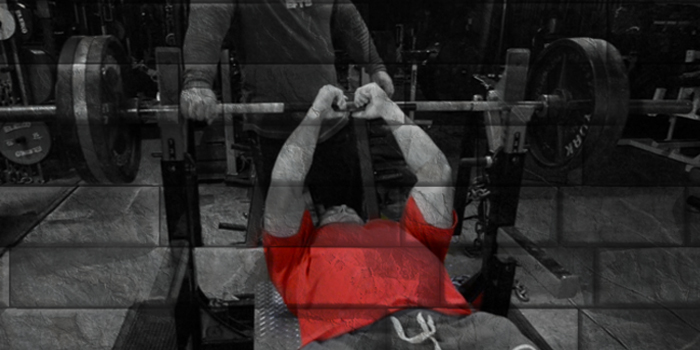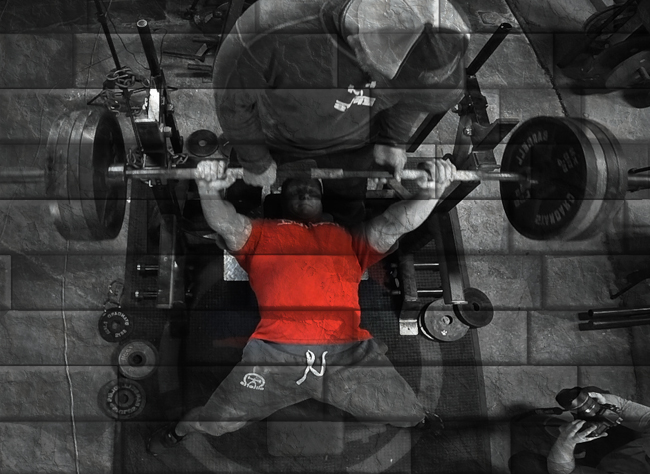
Marshall and I talk pretty regularly, and he shared with me an idea for an article for elitefts. A week beforehand, he benched 460 raw, which is good by any standard, but especially for a shirted bencher that doesn’t do a ton of raw training. He felt like the one thing holding him back was the eccentric phase of the bench:
“Unracking anything past 315 feels like 800 pounds. [He would know what that feels like, so I don’t doubt him.] The press is always strong and easy but the descent feels awful. I feel I could bench so much more raw if this wasn’t a problem.”
I think there are a couple takeaways from this. First, 300 pounds is always 300 pounds. Some days it will feel light while other days heavy, but that’s just the nature of the beast. Chad Aichs told me one time, “400 pounds in the squat NEVER felt light. Some days it moved faster than others, but it always felt heavy for me.” To hear Chad say that made me feel a lot better about the days where four plates feels like garbage. Second, as Marshall pointed out to me, the years of shirted benching have left him feeling ‘weak’ in the eccentric part of his bench. The shirt takes the brunt of the weight, as you are loading it during that phase. You still must remain tight and engaged in order to maintain bar path and be able to effectively press a maximal weight.
RELATED: Big Bench Rules to Fix Your Weak Point
I know when I’m too slow in the eccentric phase of both my squat and bench, my ability to stand up with or press anything over 90% goes in the toilet. Part of the issue is the time under tension principle. Some of it is the stretch reflex. But the majority of the pie is technique and keeping the proper muscles engaged to control the weight and maintain proper leverages. For the purpose of this article I’ll just focus on the bench press, but understand that while the muscle groups will obviously change, similar principles apply in the squat as well: external rotation, tension, stretch reflex...
If you watched Dave Tate and Matt Smith work with me on my bench press technique, you may recognize similar cues and verbiage in this section. But there are 4-5 cues I like to use when teaching the bench that apply to the eccentric phase and those cues are designed to keep certain muscle groups engaged.
Squeeze the bar.
- Squeeze hardest with the pinkies to keep the bar in line with your elbows.
Your knuckles should be white.
- Keeping your hands, wrists, and forearms firing will make weights feel a little lighter but more importantly will transfer force more efficiently.
Pinch the pad with your shoulder blades.
- Or “pull your shoulder blades back and down” to allow you to raise your sternum and shorten your ROM — essential to pressing a maximal weight and keeping your shoulders healthy.
Bend the bar.
- Again, squeezing with the pinkies will allow you to try to bend the bar into a “U” toward your feet.
- This external rotation will keep your lats engaged which is essential for the next couple of cues.
Pull the bar apart.
- Similar cue but subtle difference — pulling it apart while bending it will engage your rear delts and stabilize the bar throughout the eccentric and concentric phases.
Row the bar.
- Or “meet the bar at it’s highest point with your chest.”
- Keeping your sternum high again is essential, but doing that by rowing the bar is perfection
- You’re probably thinking “How do I row the bar on a bench press without killing myself?”
- If you keep everything engaged you will have to ‘fight’ yourself to some extent to get to your chest.
- This is one of those cues you might not get until you feel it one day by working on it every time you get under the bar.
Beginner or master, you can only work on one MAYBE two of these at a time. And they are similar enough that you might only need to focus on bending the bar and rowing the bar, for example, which for now might be enough to add immediate pounds to your bench.
Did you notice no mention of triceps or pecs? You shouldn’t be reverse benching the bar or trying to slow down the eccentric with your pressing muscles. You can do that for awhile, but your bench will stall quickly.
So how do you bring up the lats, rear delts, and mid/upper back?Check out the Exercise Index on elitefts.com for full explanations, but here are some of my essentials…
- Pull-Ups
- Iso Last Pull Downs
- Face Pulls
- Band or Machine Rear Delts
- Meadows Rows
- Chest Supported Rows
- DB/BB Rows
What else can you do to get more comfortable with the eccentric phase (and ultimately improve your bench)? I’ll give two that I have experience with and one that I want to try, which is part of a different style of training.
SPOTO PRESSES
- Start with light weight, maybe 50-60%.
- Take a moderate grip, a couple fingers inside of your competition grip.
- Get tight as your normally would and row the bar to your chest as fast as possible.
- BUT stop one to two inches off your chest, hold for a second or two, then explode back up.
- This is teaching your body to absorb force, which is the first part of redirecting force.
WATCH: Casey Williams' Bench Methods and 12-Week Raw Program
REVERSE BAND BENCH
- Watching my training partners (and I still do it myself sometimes), we slow down the eccentric as the weight gets heavier.
- Naturally as you get stronger you have to slow down the eccentric but it becomes a problem when I do it as a reaction. When you’re reacting, you’re not in control. So this changes your technique, which is a big problem.
- Reverse bands allow you to feel heavy weight while still trusting your body to keep up the speed on the eccentric because you know the bands will help you.
- We used this with my training partner Joe the other night for squats (would be the same example for his bench); he just had his second kid so he’s a little sleep deprived and his training cycle has been good, but also he’s had some tough days. He hit 90ish percent for a single and it was a grinder but I knew right away watching his eccentric he would be in trouble. He slowed down right from the start. So we threw light reverse bands on and he went on to hit it for an easy triple with a couple reps left in the tank. The biggest reason was he kept his pace on the eccentric, setting him up to stay tighter in the hole and get a stretch reflex out of the squat. Now you might say "of course it was easier he had reverse bands on" but I promise you I could have had him take that same weight again with no reverse bands and if he focused on speeding up his eccentric he would have hit it without any problems. Early on in the training cycle I’ll usually tell him to focus up and do it without the bands, but seeing as he is less than 10 weeks out from a meet, we went with the safer route.
TRIPHASIC
I won’t go into the whole program in detail here, but it looks something like this:
Weeks 1-3
- 3-5 second eccentric, 3x3
Weeks 4-6
- Iso (pause bench 3-5 sec), 3x3
Weeks 7-9
- Concentric (pause bench 1 second) 3x3
All three phases should get you more comfortable handling weights during the eccentric portion of the lift, as well as reinforcing the cue to stay tight and pull the bar down to meet your chest.













The cue section is very helpful and I will try and work on putting it all together. I realized myself that once I got to 85% and up the eccentric would slow down more and I wouldn't be in control like you mentioned in your article.
I know everyone is different but how slowly or quickly should the eccentric portion of ones bench be to yield the best results? I am still working on building those muscles you mentioned and keeping tight during the entire moment. Thank you for the Help Casey!
I have to say I think the hardest to teach as well as execute the weights gets closer to 90%, "squeezing with the pinkies will allow you to try to bend the bar into a “U” toward your feet"